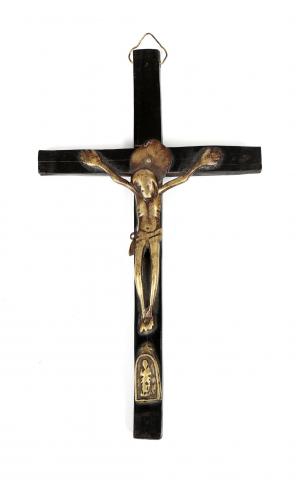Nkangi Kiditu - Crucifixo
Ébano e latão
Reino do Congo, século XVI /XVII
Dim.: 23,5 x 13,5 x 9,0 cm
Prov.: Rui Quintela, Lisboa
Peça semelhante em: Volper, 'Ora Pro Nobis', p. 63
Nkangi Kiditu - Crucifix
Ebony and brass
Kingdom of Congo, 16th-17th century
Dim. : 23,5 x 13,5 x 9,0 cm
Prov.: Rui Quintela, Lisbon
Similar piece in Volper, 'Ora Pro Nobis', p. 63
Rare, late 17th century sculpture from the Old Kingdom of Kongo, depicting the crucified Christ, on an ebony cross, with a small shrine at His feet.
This expressive image of the dying Christ, head resting on the right shoulder, suggests calm resignation. The elongated stylized figure, with ribs defined by simple parallel lines, wears a short lention tied on the right. The limbs are slender and elongated, ending in star shaped hands and crossed flattened feet, fixed by small round headed pins. A circular halo, fixed to the intersection of the cross, crowns the image.
At Christ’s feet, in a niche topped by a Greek cross, the small brass figure of a supplicant with the appearance of the Virgin Mary, alludes to images of the Virgin and John the Baptist commonly associated to Calvary scenes.
The aesthetic superiority of this crucifix can be clearly noted when compared to other contemporary examples in private and museum collections, such as the Metropolitan Museum of Art, New York (inv. nr. 1999.295.7) or the Musée Royal de l’Afrique Centrale, Tervuren (Inv. HO. 1955.9.18).
This metal and wood Nkangi Kiditu fits into a typology favoured by nganga (healers) and political authorities. By its characteristics and superb quality it embodies a milestone in a culture’s inheritance, one that incorporated Christianity through the conquest of specific symbolisms, which conformed to the ancestral rituals of the largest Central African Empire of the 16th and 17th centuries.
Rara e magnífica escultura do antigo reino do Congo, do final do século XVII, representado Cristo crucificado, com um pequeno nicho a seus pés, colocados numa cruz de ébano.
A escultura expressiva de Cristo moribundo, com a cabeça caída sobre o ombro direito e a face sem fisionomia declarada, sugere aparência de abandono. A figura é alongada e estilizada, com as costelas representadas por algumas linhas simplificadas paralelas, e veste cendal curto, apanhado à direita. De membros alongados e finos, apresenta mãos achatadas, em estrela e pés espalmados, cruzados, presos por pequenos balmázios circulares. Um “halo” ou nimbo, fixado na intersecção dos ramos da cruz, coroa Jesus Cristo.
Aos pés de Cristo destaca-se a figura de um orante, com a aparência de Nossa Senhora, num nicho de latão também denominado “alcova” encimado por cruz grega. Estas imagens tentam reproduzir as duas figuras que ladeiam o ramo maior da cruz latina, aos pés de Cristo por altura da crucificação: a Virgem e São João.
A superioridade estética deste crucifixo está patente em peças da mesma época, que chegaram aos nossos dias, através de coleções privadas, ou depositadas nos acervos de museus, como o exemplar nº1999.295.7 no The Metropolitan Museum of Art’s, Nova Iorque e o Inv. HO. 1955.9.18 do Musée Royal de l’Afrique Centrale, Tervuren.
O Nkangi Kiditu em análise, de metal e madeira, enquadra-se numa tipologia que era a preferida por nganga (curandeiros) e autoridades políticas. Representa, pelas suas características e qualidade, um marco na herança de uma cultura, que se cristianizou através da conquista de simbologias específicas, de acordo com os ritos ancestrais de um povo, que foi, durante os séculos XVI e XVII, protagonista do maior império centro-africano.
- Arte Colonial e Oriental
- Arte Cristã

